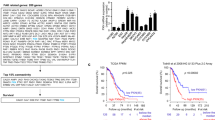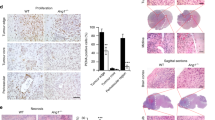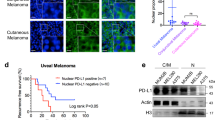Abstract
Angiogenin, a 14-kDa multifunctional pro-angiogenic growth factor, is upregulated in several types of cancers. Anti-angiogenin monoclonal antibodies used as antagonists inhibited the establishment, progression and metastasis of human cancer cells in athymic mice (Olson et al., 1994). Silencing angiogenin and inhibition of angiogenin's nuclear translocation blocked cell survival and induced cell death in B-lymphoma and endothelial cells latently infected with Kaposi sarcoma-associated herpesvirus (Sadagopan et al., 2009), suggesting that actively proliferating cancer cells could be inducing angiogenin for inhibiting apoptotic pathways. However, the mechanism of cell survival and apoptosis regulation by angiogenin and their functional significance in cancer is not known. We demonstrate that angiogenin interacts with p53 and colocalizes in the nucleus. Silencing endogenous angiogenin induced p53 promoter activation and p53 target gene (p53, p21 and Bax) expression, downregulated anti-apoptotic Bcl-2 gene expression and increased p53-mediated cell death. In contrast, angiogenin expression blocked pro-apoptotic Bax and p21 expression, induced Bcl-2 and blocked cell death. Angiogenin also co-immunoprecipitated with p53 regulator protein Mdm2. Angiogenin expression resulted in the inhibition of p53 phosphorylation, increased p53–Mdm2 interaction, and consequently increased ubiquitination of p53. Taken together, these studies demonstrate that angiogenin promotes the inhibition of p53 function to mediate anti-apoptosis and cell survival. Our results reveal for the first time a novel p53 interacting function of angiogenin in anti-apoptosis and survival of cancer cells and suggest that targeting angiogenin could be an effective therapy for several cancers.
This is a preview of subscription content, access via your institution
Access options
Subscribe to this journal
Receive 50 print issues and online access
$259.00 per year
only $5.18 per issue
Buy this article
- Purchase on Springer Link
- Instant access to full article PDF
Prices may be subject to local taxes which are calculated during checkout








Similar content being viewed by others
References
Adams JM, Cory S . (2007). Bcl-2-regulated apoptosis: mechanism and therapeutic potential. Curr Opin Immunol 19: 488–496.
Antonsson B, Montessuit S, Sanchez B, Martinou JC . (2001). Bax is present as a high molecular weight oligomer/complex in the mitochondrial membrane of apoptotic cells. J Biol Chem 276: 11615–11623.
Ashkenazi A, Dixit VM . (1998). Death receptors: signaling and modulation. Science 281: 1305–1308.
Barton DP, Cai A, Wendt K, Young M, Gamero A, De Cesare S et al. (1997). Angiogenic protein expression in advanced epithelial ovarian cancer. Clin Cancer Res 3: 1579–1586.
Chopra V, Dinh TV, Hannigan EV . (1997). Serum levels of interleukins, growth factors and angiogenin in patients with endometrial cancer. J Cancer Res Clin Oncol 123: 167–172.
Chopra V, Dinh TV, Hannigan EV . (1998). Circulating serum levels of cytokines and angiogenic factors in patients with cervical cancer. Cancer Invest 16: 152–159.
Fett JW, Strydom DJ, Lobb RR, Alderman EM, Bethune JL, Riordan JF et al. (1985). Isolation and characterization of angiogenin, an angiogenic protein from human carcinoma cells. Biochemistry 24: 5480–5486.
Foulkes WD . (2007). p53--master and commander. N Engl J Med 357: 2539–2541.
Gottlieb TM, Leal JF, Seger R, Taya Y, Oren M . (2002). Cross-talk between Akt, p53 and Mdm2: possible implications for the regulation of apoptosis. Oncogene 21: 1299–1303.
Hanahan D, Weinberg RA . (2000). The hallmarks of cancer. Cell 100: 57–70.
Haupt Y, Maya R, Kazaz A, Oren M . (1997). Mdm2 promotes the rapid degradation of p53. Nature 387: 296–299.
Hemann MT, Lowe SW . (2006). The p53–Bcl-2 connection. Cell Death Differ 13: 1256–1259.
Hu F, Gartenhaus RB, Eichberg D, Liu Z, Fang HB, Rapoport AP et al. (2010). PBK/TOPK interacts with the DBD domain of tumor suppressor p53 and modulates expression of transcriptional targets including p21. Oncogene 29: 5464–5474.
Hu GF . (1998). Neomycin inhibits angiogenin-induced angiogenesis. Proc Natl Acad Sci USA 95: 9791–9795.
Kishimoto K, Liu S, Tsuji T, Olson KA, Hu GF . (2005). Endogenous angiogenin in endothelial cells is a general requirement for cell proliferation and angiogenesis. Oncogene 24: 445–456.
Kroemer G, Zamzami N, Susin SA . (1997). Mitochondrial control of apoptosis. Immunol Today 18: 44–51.
Kubbutat MH, Jones SN, Vousden KH . (1997). Regulation of p53 stability by Mdm2. Nature 387: 299–303.
Li D, Bell J, Brown A, Berry CL . (1994). The observation of angiogenin and basic fibroblast growth factor gene expression in human colonic adenocarcinomas, gastric adenocarcinomas, and hepatocellular carcinomas. J Pathol 172: 171–175.
Li DW, Liu JP, Schmid PC, Schlosser R, Feng H, Liu WB et al. (2006). Protein serine/threonine phosphatase-1 dephosphorylates p53 at Ser-15 and Ser-37 to modulate its transcriptional and apoptotic activities. Oncogene 25: 3006–3022.
Liu S, Yu D, Xu ZP, Riordan JF, Hu GF . (2001). Angiogenin activates Erk1/2 in human umbilical vein endothelial cells. Biochem Biophys Res Commun 287: 305–310.
Liu X, Kim CN, Yang J, Jemmerson R, Wang X . (1996). Induction of apoptotic program in cell-free extracts: requirement for dATP and cytochrome c. Cell 86: 147–157.
Marchenko ND, Wolff S, Erster S, Becker K, Moll UM . (2007). Monoubiquitylation promotes mitochondrial p53 translocation. EMBO J 26: 923–934.
Meek DW . (1994). Post-translational modification of p53. Semin Cancer Biol 5: 203–210.
Milczarek GJ, Martinez J, Bowden GT . (1997). p53 Phosphorylation: biochemical and functional consequences. Life Sci 60: 1–11.
Montero S, Guzman C, Cortes-Funes H, Colomer R . (1998). Angiogenin expression and prognosis in primary breast carcinoma. Clin Cancer Res 4: 2161–2168.
Moroianu J, Riordan JF . (1994). Nuclear translocation of angiogenin in proliferating endothelial cells is essential to its angiogenic activity. Proc Natl Acad Sci USA 91: 1677–1681.
Olson KA, French TC, Vallee BL, Fett JW . (1994). A monoclonal antibody to human angiogenin suppresses tumor growth in athymic mice. Cancer Res 54: 4576–4579.
Oltvai ZN, Milliman CL, Korsmeyer SJ . (1993). Bcl-2 heterodimerizes in vivo with a conserved homolog, Bax, that accelerates programmed cell death. Cell 74: 609–619.
Perfettini JL, Castedo M, Nardacci R, Ciccosanti F, Boya P, Roumier T et al. (2005). Essential role of p53 phosphorylation by p38 MAPK in apoptosis induction by the HIV-1 envelope. J Exp Med 201: 279–289.
Riley T, Sontag E, Chen P, Levine A . (2008). Transcriptional control of human p53-regulated genes. Nat Rev Mol Cell Biol 9: 402–412.
Sadagopan S, Sharma-Walia N, Veettil MV, Bottero V, Levine R, Vart RJ et al. (2009). Kaposi's sarcoma-associated herpesvirus upregulates angiogenin during infection of human dermal microvascular endothelial cells, which induces 45S rRNA synthesis, antiapoptosis, cell proliferation, migration, and angiogenesis. J Virol 83: 3342–3364.
Sadagopan S, Valiya Veettil M, Paudel N, Bottero V, Chandran B . (2011). Kaposi's sarcoma-associated herpesvirus-induced angiogenin plays roles in latency via the phospholipase C gamma pathway: blocking angiogenin inhibits latent gene expression and induces the lytic cycle. J Virol 85: 2666–2685.
Shieh SY, Ahn J, Tamai K, Taya Y, Prives C . (2000). The human homologs of checkpoint kinases Chk1 and Cds1 (Chk2) phosphorylate p53 at multiple DNA damage-inducible sites. Genes Dev 14: 289–300.
Shieh SY, Ikeda M, Taya Y, Prives C . (1997). DNA damage-induced phosphorylation of p53 alleviates inhibition by MDM2. Cell 91: 325–334.
Shimoyama S, Gansauge F, Gansauge S, Negri G, Oohara T, Beger HG et al. (1996). Increased angiogenin expression in pancreatic cancer is related to cancer aggressiveness. Cancer Res 56: 2703–2706.
Tsuji T, Sun Y, Kishimoto K, Olson KA, Liu S, Hirukawa S et al. (2005). Angiogenin is translocated to the nucleus of HeLa cells and is involved in ribosomal RNA transcription and cell proliferation. Cancer Res 65: 1352–1360.
Vogelstein B, Lane D, Levine AJ . (2000). Surfing the p53 network. Nature 408: 307–310.
Waldman T, Kinzler KW, Vogelstein B . (1995). p21 is necessary for the p53-mediated G1 arrest in human cancer cells. Cancer Res 55: 5187–5190.
Xu ZP, Tsuji T, Riordan JF, Hu GF . (2003). Identification and characterization of an angiogenin-binding DNA sequence that stimulates luciferase reporter gene expression. Biochemistry 42: 121–128.
Yu SW, Wang H, Poitras MF, Coombs C, Bowers WJ, Federoff HJ, Poirier GG et al. (2002). Mediation of poly(ADP-ribose) polymerase-1-dependent cell death by apoptosis-inducing factor. Science 297: 259–263.
Acknowledgements
This study was supported in part by Public Health Service grants, AI 091767 and the RFUMS—HM Bligh Cancer Research Fund to BC. We thank Dr AP Rapoport (University of Maryland) for providing p53 constructs. We thank Dr B Vogelstein (Johns Hopkins University) for the p53+/+ and p53−/− HCT116 cell lines. We thank Keith Philibert for critically reading the manuscript and Bob Dickinson for FACS analysis at the RFUMS core facility.
Author contributions: SS, MVV and BC designed the experiments. SS, MVV, SC, NP, VB and NSW performed the experiments. MVV, SS and BC wrote the paper.
Author information
Authors and Affiliations
Corresponding author
Ethics declarations
Competing interests
The authors declare no conflict of interest.
Additional information
Supplementary Information accompanies the paper on the Oncogene website
Rights and permissions
About this article
Cite this article
Sadagopan, S., Veettil, M., Chakraborty, S. et al. Angiogenin functionally interacts with p53 and regulates p53-mediated apoptosis and cell survival. Oncogene 31, 4835–4847 (2012). https://doi.org/10.1038/onc.2011.648
Received:
Revised:
Accepted:
Published:
Issue Date:
DOI: https://doi.org/10.1038/onc.2011.648
Keywords
This article is cited by
-
Senescent cells limit p53 activity via multiple mechanisms to remain viable
Nature Communications (2022)
-
Osteoclasts protect bone blood vessels against senescence through the angiogenin/plexin-B2 axis
Nature Communications (2021)
-
Streamlined computational pipeline for genetic background characterization of genetically engineered mice based on next generation sequencing data
BMC Genomics (2019)
-
A novel ligand-receptor relationship between families of ribonucleases and receptor tyrosine kinases
Journal of Biomedical Science (2018)
-
Migration towards SDF-1 selects angiogenin-expressing bone marrow monocytes endowed with cardiac reparative activity in patients with previous myocardial infarction
Stem Cell Research & Therapy (2015)



